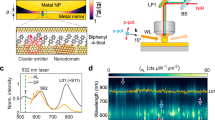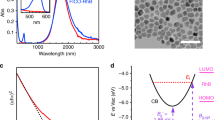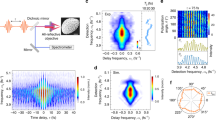Abstract
Control of the radiative properties of functional molecules near metals is a key issue in nano-optics, and is particularly important in the fields of energy transfer and light manipulation at the nanoscale1,2 and the development of plasmonic devices3,4,5. Despite the various vibronic transitions (S1(v′) → S0(v)) available for frequency tuning of fluorescence, the molecular emissions near metals reported to date have been subject to Kasha's rule, with radiative decay from the lowest excited state (S1(0)) (refs 6–10). Here, we show resonant hot electroluminescence arising directly from higher vibronic levels of the singlet excited state (S1(v′ > 0)) for porphyrin molecules confined inside a nanocavity in a scanning tunnelling microscope, by spectrally tuning the frequency of plasmons. We also demonstrate the generation of unexpected upconversion electroluminescence. These observations suggest that the local nanocavity plasmons behave like a strong coherent optical source with tunable energy, and can be used to actively control the radiative channels of molecular emitters by means of intense resonance enhancement of both excitation and emission.
This is a preview of subscription content, access via your institution
Access options
Subscribe to this journal
Receive 12 print issues and online access
$209.00 per year
only $17.42 per issue
Buy this article
- Purchase on Springer Link
- Instant access to full article PDF
Prices may be subject to local taxes which are calculated during checkout




Similar content being viewed by others
References
Chance, R. R., Prock, A. & Silbey, R. Molecular fluorescence and energy transfer near interfaces. Adv. Chem. Phys. 37, 1–65 (1978).
Greffet, J.-J. Nanoantennas for light emission. Science 308, 1561–1563 (2005).
Michaelis, J., Hettich, C., Mlynek, J. & Sandoghdar, V. Optical microscopy using a single-molecule light source. Nature 405, 325–328 (2000).
Barnes, W. L., Dereux, A. & Ebbesen, T. W. Surface plasmon subwavelength optics. Nature 424, 824–830 (2003).
Chang, D. E., Sørensen, A. S., Hemmer, P. R. & Lukin, M. D. Quantum optics with surface plasmons. Phys. Rev. Lett. 97, 053002 (2006).
Kühn, S., Håkanson, U. H., Rogobete, L. & Sandoghdar, V. Enhancement of single-molecule fluorescence using a gold nanoparticle as an optical nanoantenna. Phys. Rev. Lett. 97, 017402 (2006).
Anger, P., Bharadwaj, P. & Novotny, L. Enhancement and quenching of single-molecule fluorescence. Phys. Rev. Lett. 96, 113002 (2006).
Wrigge, G., Gerhardt, I., Hwang, J., Zumofen, G. & Sandoghdar, V. Efficient coupling of photons to a single molecule and the observation of its resonance fluorescence. Nature Phys. 4, 60–66 (2008).
Ringler, M. et al. Shaping emission spectra of fluorescent molecules with single plasmonic nanoresonators. Phys. Rev. Lett. 100, 203002 (2008).
Tam, F., Goodrich, G. P., Johnson, B. R. & Halas, N. J. Plasmonic enhancement of molecular fluorescence. Nano Lett. 7, 496–501 (2007).
Rebane, K. & Saari, P. Hot luminescence and relaxation processes in resonant secondary emission of solid matter. J. Lumin. 16, 223–243 (1978).
Ritchie, G. & Burstein, E. Luminescence of dye molecules adsorbed at a Ag surface. Phys. Rev. B 24, 4843–4846 (1981).
Le Ru, E. C. et al. Mechanisms of spectral profile modification in surface-enhanced fluorescence. J. Phys. Chem. C 111, 16076–16079 (2007).
Aizpurua, J., Hoffmann, G., Apell, S. P. & Berndt, R. Electromagnetic coupling on an atomic scale. Phys. Rev. Lett. 89, 156803 (2002).
Johansson, P. Light emission from a scanning tunneling microscope: fully retarded calculation. Phys. Rev. B 58, 10823–10834 (1998).
Qiu, X. H., Nazin, G. V. & Ho, W. Vibrationally resolved fluorescence excited with submolecular precision. Science 299, 542–546 (2003).
Dong, Z. C. et al. Vibrationally resolved fluorescence from organic molecules near metal surfaces in a scanning tunneling microscope. Phys. Rev. Lett. 92, 086801 (2004).
Ćavar, E. et al. Fluorescence and phosphorescence from individual C60 molecules excited by local electron tunneling. Phys. Rev. Lett. 95, 196102 (2005).
Berndt, R. et al. Photon emission at molecular resolution induced by a scanning tunneling microscope. Science 262, 1425–1427 (1993).
Gouterman, M. Optical Spectra and Electronic Structure of Porphyrins and Related Rings in The Porphyrins (ed. Dolphin, D.) Vol. 3, Ch. 1, 1–165 (Academic Press, 1978).
Schull, G., Neel, N., Johansson, P. & Berndt, R. Electron–plasmon and electron–electron interactions at a single atom contact. Phys. Rev. Lett. 102, 057401 (2009).
Aizpurua, J., Apell, S. P. & Berndt, R. Role of tip shape in light emission from the scanning tunneling microscope. Phys. Rev. B 62, 2065–2073 (2000).
Zhao, J. et al. Interaction of plasmon and molecular resonances for rhodamine 6G adsorbed on silver nanoparticles. J. Am. Chem. Soc. 129, 7647–7656 (2007).
Lombardi, J. R., Birke, R. L., Lu, T. & Xu, J. Charge transfer theory of surface enhanced Raman spectroscopy: Herzberg–Teller contributions. J. Chem. Phys. 84, 4174–4180 (1986).
Bellessa, J., Bonnand, C., Plenet, J. C. & Mugnier, J. Strong coupling between surface plasmons and excitons in an organic semiconductor. Phys. Rev. Lett. 93, 036404 (2004).
Helmchen, F. & Denk, W. Deep tissue two-photon microscopy. Nature Methods 2, 932–940 (2005).
Hoffmann, G., Berndt, R. & Johansson, P. Two-electron photon emission from metallic quantum wells. Phys. Rev. Lett. 90, 046803 (2003).
Uemura, T. et al. Local-plasmon-enhanced up-conversion fluorescence from copper phthalocyanine. Chem. Phys. Lett. 448, 232–236 (2007).
Maher, R. C., Galloway, C. M., Le Ru, E. C., Cohen, L. F. & Etchegoin, P. G. Vibrational pumping in surface enhanced Raman scattering (SERS). Chem. Soc. Rev. 37, 965–979 (2008).
Zheludev, N. I., Prosvirnin, S. L., Parasimakis, N. & Fedotov, V. A. Lasing spaser. Nature Photon. 2, 351–354 (2008).
Acknowledgements
The authors acknowledge discussions with B. Wang and X.P. Wang, and support from the National Basic Research Program of China (grant nos 2006CB922003 and 2010CB923300), the Chinese Academy of Sciences (grant no. KJCX2.YW.H06) and the Natural Science Foundation of China (grant nos 10574117 and 10974186).
Author information
Authors and Affiliations
Contributions
X.L.Z. and H.Y.G. contributed equally to this work. Z.C.D., Y.L. and J.G.H. supervised the project, designed experiments, analysed the data and wrote the paper. X.L.Z. and H.Y.G. performed experiments and analysed data. C.Z., L.G.C. and R.Z. performed experiments. X.T. and Y.Z. performed simulations and data analysis. J.L.Y. analysed data and edited the paper.
Corresponding authors
Ethics declarations
Competing interests
The authors declare no competing financial interests.
Supplementary information
Rights and permissions
About this article
Cite this article
Dong, Z., Zhang, X., Gao, H. et al. Generation of molecular hot electroluminescence by resonant nanocavity plasmons. Nature Photon 4, 50–54 (2010). https://doi.org/10.1038/nphoton.2009.257
Received:
Accepted:
Published:
Issue Date:
DOI: https://doi.org/10.1038/nphoton.2009.257
This article is cited by
-
Hot luminescence from single-molecule chromophores electrically and mechanically self-decoupled by tripodal scaffolds
Nature Communications (2023)
-
Plasmonic phenomena in molecular junctions: principles and applications
Nature Reviews Chemistry (2022)
-
Investigation of electronic excited states in single-molecule junctions
Nano Research (2022)
-
Distance-Dependent Plasmon-Enhanced Fluorescence of Submonolayer Rhodamine 6G by Gold Nanoparticles
Nanoscale Research Letters (2021)
-
Probing intramolecular vibronic coupling through vibronic-state imaging
Nature Communications (2021)



